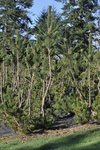And if you think my trees are styled like poodles, well,
No, yours don't have that look.
I know he mentions climate and timing.
What I'm saying is it is more on depth than simply adjusting timing. To truely heed the climate difference means an entirely different schedule.
I think the South is able to eke out a bit more "health" (not growth growth is finite), so this technique can be employed.
But I also feel like you, (the South), could also best utilize that extra health, in manners different than Japanese methods.
Since, I don't believe Japan has a range so warm so long. Of course, I don't know for certain.
Exploring these important differences and truth, can find us all with healthier, more beautiful trees, IMo.
I'm not here to say I am better, or anyone's trees are not beautiful, I just know they all can go to one better level, regardless of current education.
What else....
That Style Raku Bowl was born in connection with war and changes of parties.
So on one hand, I believe it is ok we bicker our way into a better aesthetic....
But my real heart believes the Egyptian teachings, of a more feminine society, bringing a even higher degree of art, education, and advancement.
I remain in that realm, which is why I remain misunderstood, and people infer conflict, where I bear none.
Sorce





